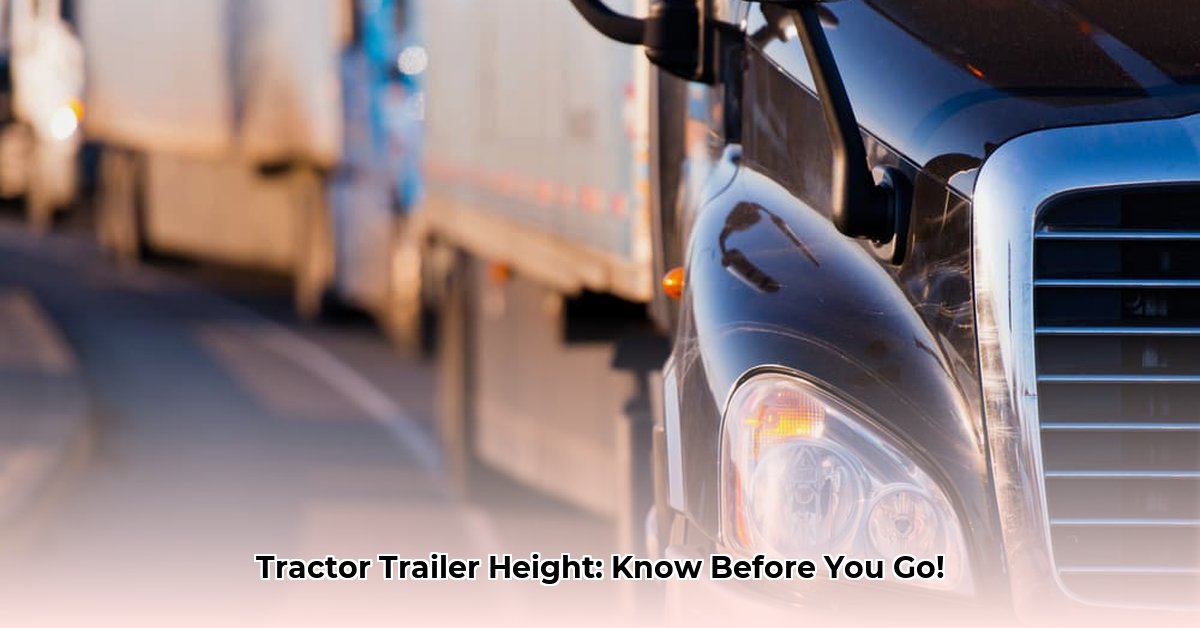
Big rigs, eighteen-wheelers, tractor-trailers—no matter what you call them, these massive vehicles are a ubiquitous presence on our highways. But have you ever considered their precise height? It's not as straightforward as you might think. While the average height hovers around 13.5 to 13.6 feet, significant variations exist depending on the trailer type. For more detailed information on average heights, check out this helpful resource. This comprehensive guide will clarify these differences, outline relevant regulations, and provide practical advice for various stakeholders.
Standard Tractor-Trailer Height: The Baseline
The typical height of a standard dry van tractor-trailer is 13.5 to 13.6 feet (approximately 162 to 163 inches). This dimension is crucial for road safety and infrastructure design. Most roads and bridges are built to accommodate this standard height. Exceeding this height can lead to accidents and infrastructure damage. However, this is just the starting point; significant variations exist.
Variations in Height Based on Trailer Type
The most significant factor influencing a tractor-trailer's height is the type of trailer being used. A dry van, designed for general cargo, generally adheres to the 13.5-13.6-foot standard. Specialized trailers, however, have different height profiles.
| Trailer Type | Approximate Height Range (feet) | Typical Cargo | Notes |
|---|---|---|---|
| Dry Van | 13.5 - 13.6 | General Freight, packaged goods | The standard; your benchmark height. |
| Reefer | 13.5 - 14.0 | Temperature-sensitive goods (frozen foods, pharmaceuticals) | Refrigeration units add height. |
| Flatbed | 13.5 - 14.0+ | Oversized or uncrated goods (lumber, machinery) | Height highly dependent on cargo. |
| Step Deck | 14.0+ | Heavy equipment, construction materials | Lowered deck for easier loading; inherently taller. |
| Double Drop | 14.0+ | Extremely heavy/oversized loads | Two decks, significantly lower loading height, but very tall overall. |
| Conestoga | 13.5 - 14.5 | Bulk goods, oversized and oddly-shaped cargo | Adjustable sides, height varies considerably with cargo. |
These are approximate ranges. Actual heights depend on manufacturer, model, and cargo load. Always consult manufacturer specifications for precise dimensions. Remember, these are total heights—from ground to the highest point of the load.
Isn't it fascinating how much variation exists even within the seemingly simple category of "tractor-trailer"? This variation underscores the importance of understanding specific trailer types in the context of road safety and regulatory compliance.
Practical Implications for Stakeholders
Understanding trailer height is crucial for various stakeholders. Trucking companies need this information for pre-trip inspections and route planning, ensuring legal and safe operations. Shippers must provide accurate cargo dimensions to prevent delays and damage. Logistics planners factor height restrictions into route optimization, utilizing specialized software to navigate low bridges and overpasses, thereby achieving efficient shipping. Regulatory bodies use height data to enforce regulations and maintain road safety.
Legal and Regulatory Considerations: Navigating Height Restrictions
Height restrictions are not mere suggestions; they're legally binding regulations. Exceeding them can result in significant fines, delays, and safety hazards. Oversized loads often require special permits, meticulous route planning, and sometimes escort vehicles to ensure safe passage. Ignoring these regulations can lead to accidents, infrastructure damage, and severe penalties. Always check local and state regulations before operating oversized loads.
Conclusion: Height, Safety, and Efficient Operations
Understanding the variations in tractor-trailer heights is pivotal for road safety and efficient operations. From trucking companies and shippers to logistics planners and regulatory agencies, everyone must prioritize awareness of height limitations and adherence to regulations. This knowledge safeguards the safety of all road users and fosters smoother, more efficient transportation. Let's collectively strive for safer and more efficient roads.